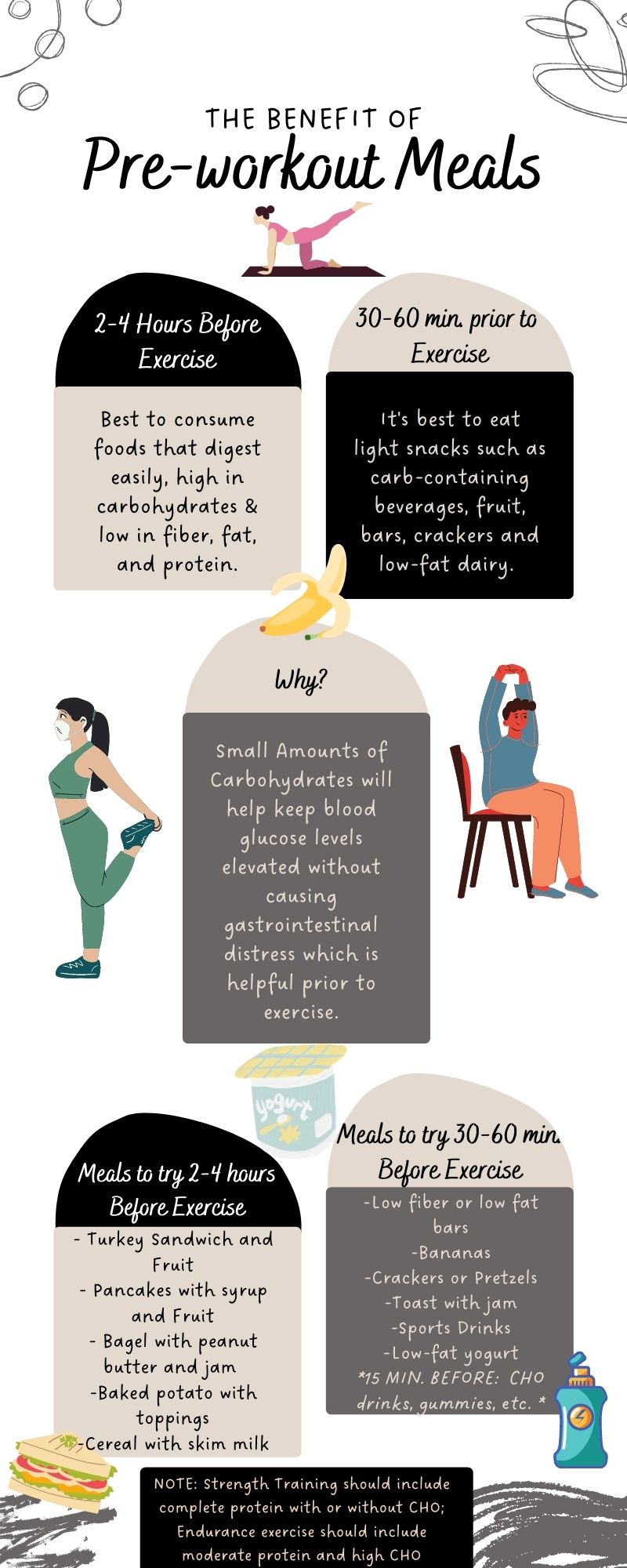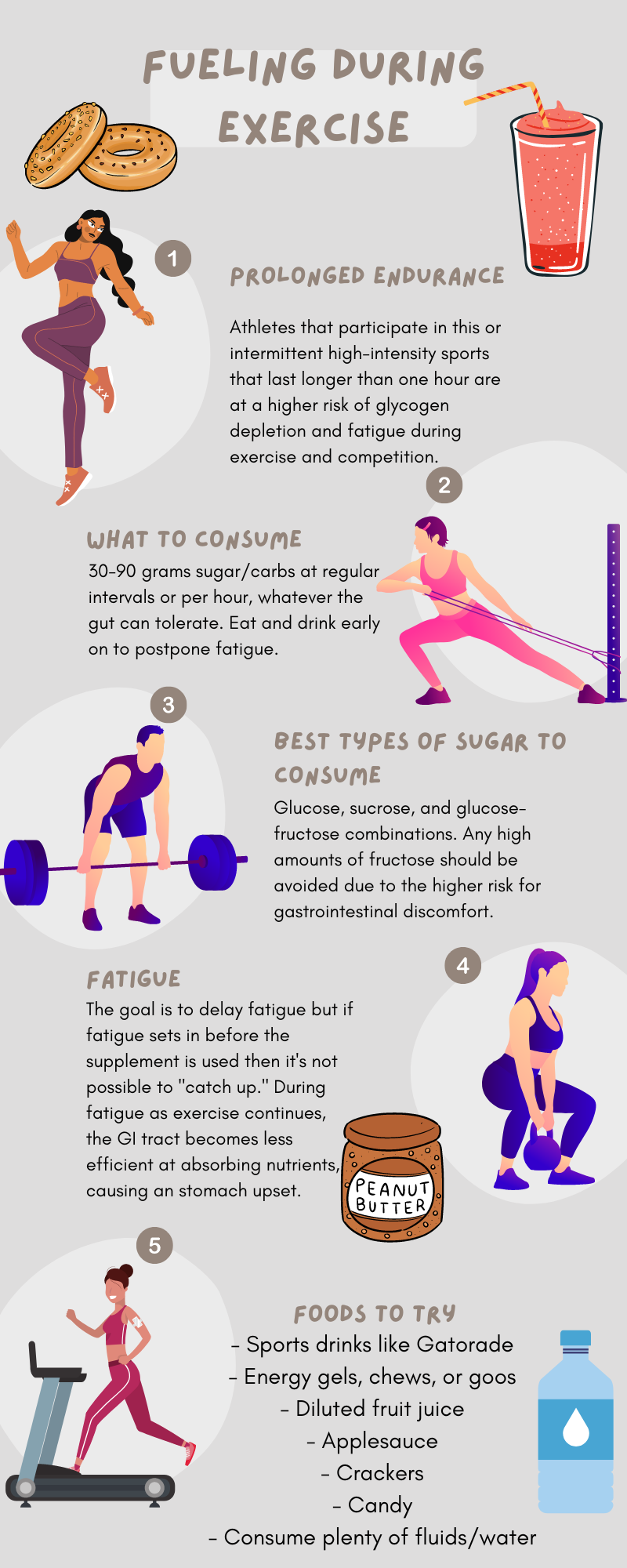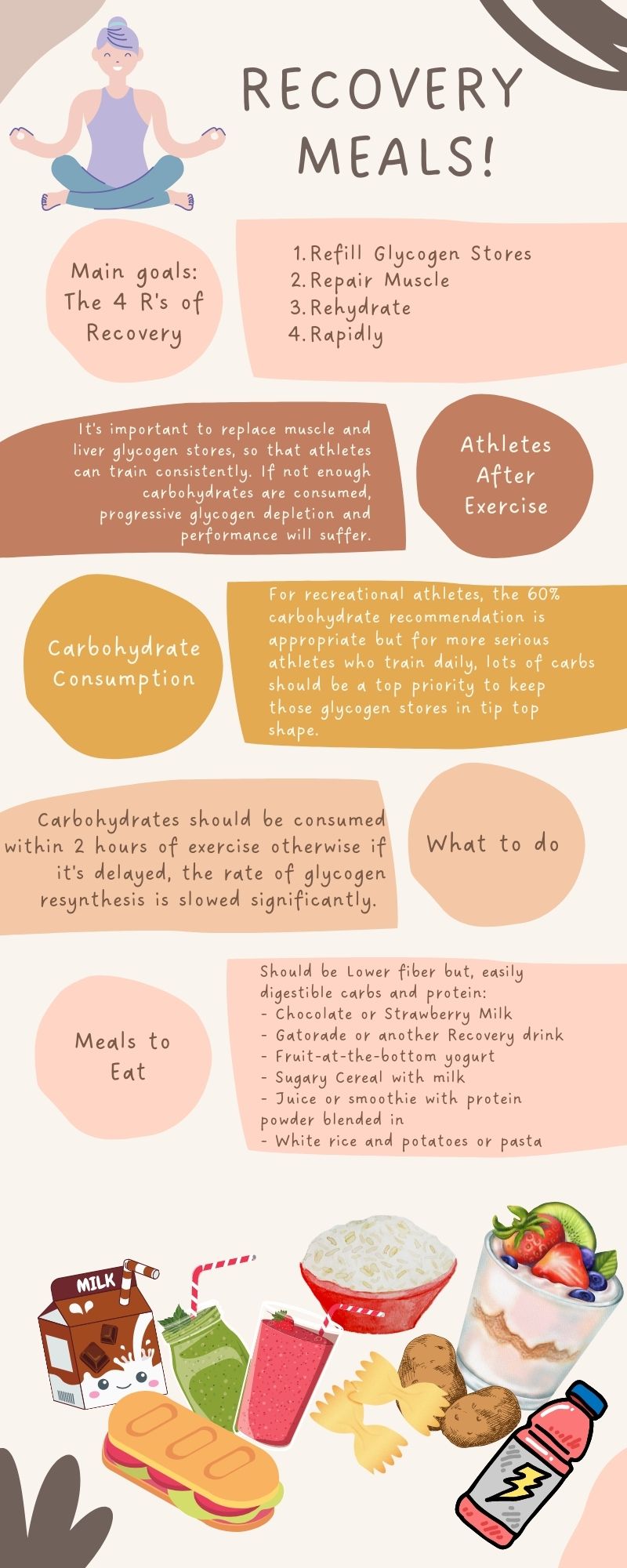5.7 Carbohydrate and Exercise
As discussed previously, carbohydrate is the fastest, most immediate source of energy and therefore the most important energy source during exercise. Low carbohydrate diets have been shown to impair sport performance and can impact an athlete’s ability to train effectively (9). Carbohydrate needs for an individual depend on both intensity and duration of exercise as well as performance goals and the weight of the athlete. Not all athletes have the same carbohydrate requirements. However, we can still say that carbohydrate is the most important macronutrient for most athletes because it must be replaced on a daily basis. If glycogen is not fully replenished after a training session, an athlete becomes at risk for progressive glycogen depletion which can lead to fatigue and impaired performance in subsequent training sessions.
Glycogen storage in the human body is limited and if glycogen stores are maximized, there is at best a 24 hour supply of glycogen. In contrast, fat, the body’s other major energy source, can be stored in unlimited quantities. However, as we will cover in chapter 8, fat metabolism is much more complex than carbohydrate metabolism. At rest or during light exercise, fat is the primary energy source but as exercise intensity increases the body needs a more immediate source of energy. At moderate to high intensity exercise, carbohydrate will be the primary energy source and carbohydrate is used almost exclusively during maximal intensity exercise. During endurance exercise, a well conditioned person could exercise for several hours at moderate intensity (40-50% capacity) before depleting glycogen stores and reaching exhaustion. At higher intensities (70–80% capacity), exhaustion will occur within 1–2 hours for the same well conditioned person. Therefore, both intensity and duration need to be considered when estimating carbohydrate needs.
The recommended amount of carbohydrate for athletes and highly active individuals ranges from 3-12 grams of carbohydrate per kilogram of body weight (g/kg) (9). This intake is personalized based on the intensity and duration of the individual’s training.
Table 5.3 Carbohydrate Recommendations for Active Individuals (9)
| Type of Activity | Recommendation |
| Low intensity exercise, technical sports, or skill based activities (golf, etc.) | 3-5 g/kg |
| Moderate to high intensity non-endurance activity, some moderate intensity endurance exercise, 1 hour a day | 5-7 g/kg |
| High intensity endurance exercise, 1-3 hours a day | 6-10 g/kg |
| Extreme commitment, 4-5 hours a day of moderate to high intensity endurance exercise | 8-12 g/kg |
Using the information in Table 5.3 and your body weight, you can calculate your personalized carbohydrate recommendation. First, convert your weight in pounds to kilograms. Then, based on your activity patterns, choose an appropriate amount of carbohydrate from the table above. Finally, multiply these numbers together.
Examples
Calculate the carbohydrate recommendation for a 145 pound woman who participates in crossfit 3 hours a week and does 5 hours a week of trail running.
- Convert lbs to kg: 145/2.2 = 65.9 kg
- Choose carbohydrate range: This woman does approximately 8 hours of endurance and non-endurance exercise each week. Crossfit is high intensity and trail running could be either moderate to high intensity so we will choose a carbohydrate recommendation of 6 g/kg.
- Carbohydrate recommendation = 65.9 kg x 6 g/kg = 395.4 grams of carbohydrate: This woman requires approximately 400 grams of carbohydrate per day. If her trail runs are more intense, she might benefit from increasing her carbohydrate intake up to 7 g/kg. This is something that she can fine tune through trial and error.
As you can see, the 145 pound woman in the example above requires approximately 400 grams of carbohydrate per day. This is well above the RDA of 130 grams of carbohydrate per day. As stated earlier, the RDA for carbohydrate is the minimum amount of carbohydrate required for brain function but individuals who are active often require much more.
Carbohydrate Intake Before Exercise
Figure 5.16 Pre-Workout Carbohydrate

When planning pre-workout meals and snacks, there are three main goals: 1) avoid hunger, 2) delay fatigue, and 3) prevent gastrointestinal surprises. You can think of pre-workout meals as “topping up” the body’s carbohydrate stores and maximizing muscle glycogen. To prevent gastrointestinal surprises, an athlete should avoid unfamiliar foods before training or competition and practice pre-competition meals during training. The macronutrient content and size of the meal depend on how close the meal is eaten prior to exercise. In general, the closer to exercise, the smaller and easier to digest the meal should be. This is because to allow time for the meal to be digested and absorbed before exercise begins so that blood flow can be prioritized to the exercising muscles, not the digestive system. Foods that slow digestion, such as fiber and fat, should be avoided in high amounts prior to exercise. The intensity and duration of the workout as well as the athlete’s individual preferences should be taken into consideration.
If time permits, an athlete should aim for a meal or snack in the 1-4 hours prior to a workout. Most athletes can tolerate a full meal 2-4 hours prior to a workout, this meal should be relatively high in carbohydrate and contain some protein. Moderate amounts of fat and fiber are likely okay as well, but again, depend on the individual. Some examples of foods to include are a burrito with rice and lean protein or lean protein sandwich with a side of fruit or veggies. Athletes should avoid foods that cause gastrointestinal discomfort or bloating. Within 1-2 hours of a workout, smaller snacks or meals high in carbohydrate with a moderate amount of protein and minimal fat and fiber are usually best. Some examples include hard boiled eggs and a banana, low fat greek yogurt or string cheese with fruit, half a turkey sandwich and applesauce, or low fat cottage cheese and fruit. Meals eaten less than an hour before exercise should be quick digesting sources of carbohydrate. Think things you can sip or nibble like sports drinks, fruit juices, applesauce, and crackers. Some athletes may be able to tolerate a fruit smoothie, just pay attention to the serving size. Again, these pre-workout meals should be practiced during training so you can train your gastrointestinal tract and see how different combinations of food affect your body.
In some situations, such as in preparation for a competition or event more than 90 minutes in duration, athletes may participate in carbohydrate loading during the days leading up to the event. The goal of carbohydrate loading is to maximize the amount of glycogen stored in the muscles. In order to achieve this, athletes “taper” or severely reduce their training volume while consuming 10-12 g/kg/day of carbohydrate for approximately 2-3 days prior to competition. As training volume is reduced, less carbohydrate is being used for fuel and the body supercompensates by storing this excess carbohydrate as glycogen temporarily. The excess glycogen will allow the athlete to exercise longer at a high intensity before fatigue sets in. While carbohydrate loading is most often used by endurance athletes, a modified version can also be used by bodybuilders before a show in order to make the muscles appear fuller and more defined.
Carbohydrate Intake During Exercise
Figure 5.17 Fueling During Exercise

Individuals that participate in endurance or intermittent high-intensity sports, including stop and go sports, that last longer than one hour are at higher risk of glycogen depletion and fatigue during training and competition. Consuming carbohydrates during exercise can help to maintain blood glucose levels, provide energy, and delay fatigue. Muscle glycogen stores are not replenished during exercise, therefore, initial muscle glycogen stores are still important for optimal performance. For intermittent high-intensity sports and endurance events lasting between 1-2.5 hours, athletes are recommended to consume between 30-60 g of carbohydrate per hour. Athletes participating in endurance events lasting more than 2.5 hours may require up to 90 g of carbohydrate per hour (9). In order to prevent gastrointestinal discomfort, simple carbohydrates that can be digested and absorbed quickly are recommended. As fatigue sets in, blood flow is redirected from the gastrointestinal tract to the working muscle and digestion slows down. This makes the gastrointestinal tract less efficient at absorbing nutrients and is likely to lead to gastrointestinal distress. This is why athletes are encouraged to eat and drink early in the workout or competition in order to delay fatigue. If fatigue begins to set in before supplement use, then it will be too late to catch up.
Sports nutrition products such as energy gels, goos, chews, or beverages are all good choices for fueling during a workout or competition. However, diluted fruit juices, applesauce, crackers, pretzels, and candies can also work for athletes who want to mix up the taste and texture of their fuel sources. Glucose is the best source of carbohydrate during a workout because it is available for use immediately after digestion and absorption – fructose and galactose must be converted to glucose before they can be used for energy. The human body can oxidize approximately 60 g of glucose per hour. However, glucose:fructose mixtures can be oxidized at rates of up to 100 g of carbohydrate per hour so, especially for athletes participating in endurance events lasting longer than 2.5 hours, a glucose: fructose combo is best (10). Athletes should be careful to avoid high amounts of fructose during training or competition though as high intakes of fructose can lead to gastrointestinal discomfort. For this reason, athletes who eat fruit during exercise often dilute fruit juice or pair a piece of fruit with another source of glucose like crackers or pretzels. Commercially available sports nutrition products usually include a combination of glucose and fructose, but each product has a slightly different formula. You can read the labels to see what types of sugar each product contains and choose a product that works for you. The amount and type of carbohydrate that can be tolerated by the gastrointestinal tract is very individual, and the best way to determine what works best for you is to practice during training. Never try anything during competition that you have not practiced in advance because you may end up on the sidelines!
Carbohydrate Intake After Exercise
Figure 5.18 Recovery Meals

After exercise, especially if the training session is long or intense (or both), an athlete’s muscle and liver glycogen stores will be depleted. It is important to replenish these glycogen stores to prevent progressive glycogen depletion and allow the athlete to train on consecutive days. With a normal diet containing 60% carbohydrate, it can take 20 hours or more to fully replenish glycogen stores. This slow rate of glycogen synthesis is not a problem for recreational athletes and those who do not train daily since there is plenty of time between workouts for glycogen stores to be replenished. However, for more serious athletes who train daily or multiple times a day, it may be a problem. For these individuals, the diet can be manipulated to speed up recovery and enhance glycogen repletion. If an athlete is training once a day, but is able to consume appropriate amounts of carbohydrate for their activity level, manipulation of the diet may not be necessary to replenish glycogen stores. However, many collegiate athletes and active individuals do not consume adequate amounts of carbohydrate for their lifestyle and may benefit from the strategies outlined below.
Two things are needed to maximize glycogen resynthesis post-exercise: carbohydrate and insulin. Insulin, as discussed earlier in this chapter, is necessary to promote the uptake of glucose by the cells. When you consume foods and beverages that contain carbohydrate, you are providing your body with the glucose needed to refill glycogen stores and stimulating the release of insulin by the pancreas at the same time. Glycogen stores can be refilled at higher rates when carbohydrates are consumed within 2 hours after exercise. This is due to the fact that exercise stimulates the signaling of GLUT-4 transporters to the cell membrane, independent of insulin. When carbohydrate consumption is delayed for several hours after exercise the rate of glycogen resynthesis is slowed by as much as 50% (11). Therefore, it is recommended to consume carbohydrates as soon after the training session as possible. The type of carbohydrates the athlete chooses may be important as well. Quick delivery of carbohydrate to the liver and muscles is desirable so foods that are digested and absorbed rapidly are more beneficial (high glycemic foods). If a recovery beverage or supplement is used, then it is best to choose one that contains glucose or sucrose as the primary sugar. Athletes may choose foods with fructose, such as fruit or fruit juices. However, fructose has a lower glycemic index than glucose which means that it is not digested and absorbed as rapidly as glucose which can lead to slower rates of glycogen resynthesis.
To maximize glycogen synthesis, it is recommended that athletes consume between 0.75 and 1.5 g of carbohydrate per kilogram of body weight, as soon as possible, after exercise. If the exercise duration is particularly long and intense, then carbohydrate should continue to be consumed in this amount each hour after exercise for up to 3–4 hours, depending on the need for glycogen repletion. It does not matter if the carbohydrate is consumed in liquid (beverages) or solid (foods) form. The addition of protein or amino acids increases the rate of glycogen synthesis and enhances post-workout protein synthesis and muscle recovery (12). Examples of foods that provide both quickly digested carbohydrate and protein are chocolate milk, fruit-at-the-bottom yogurt, cereal with milk, or a turkey sandwich.
Media Attributions
- Benefits of Pre-workout Meals © Natalie Fox is licensed under a CC BY (Attribution) license
- Fueling During Exercise © Natalie Fox is licensed under a CC BY (Attribution) license
- Recovery Meals © Natalie Fox is licensed under a CC BY (Attribution) license
